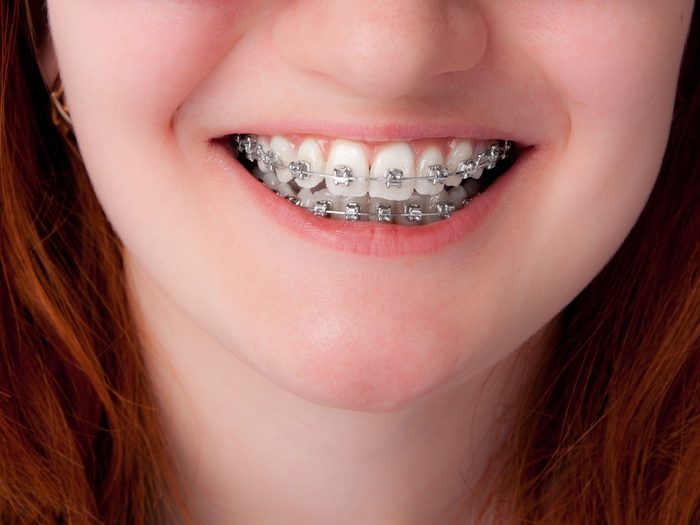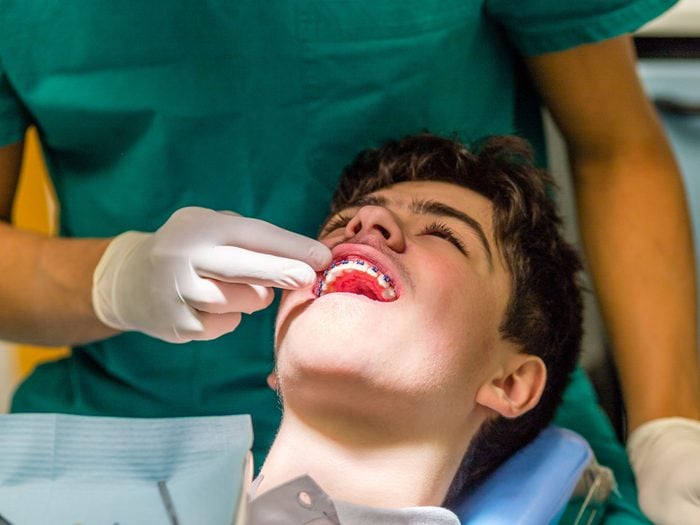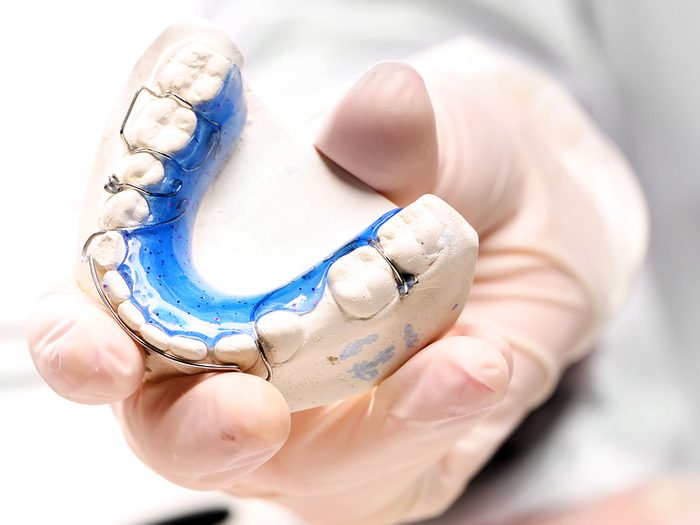
When the orthodontist tells you your child needs braces…
I didn’t want to hear this. The orthodontist leaned forward, smiled and told me my 12-year-old son, Tom, needed to wear braces for two years. After that, retainers. Probably for another two years. He also recommended a palate expander, a device placed in the roof of the mouth to make it wider and give the teeth more room. The cost: $5,600.
Tom was reluctant to go ahead. So was I. It seemed like a lot of intervention, especially since Tom’s teeth looked pretty normal to me. Naturally, I didn’t like the idea of spending $5,600, but I had another reason to hesitate. Despite my nagging, Tom wasn’t good about brushing his teeth. I worried that braces might cause worse problems than we already had.
When I told Tom’s pediatric dentist about our reluctance, he said Tom would be fine without braces. I breathed a sigh of relief and thought that was the end of it. But then almost two years later, I took him to Dr. William Scott in Vancouver-my own trusted dentist. He suggested Tom revisit an orthodontist. Tom’s teeth were now crowded and a bit crooked, and therefore more difficult to clean. He was thus at higher risk of developing cavities or inflamed gums.
Seeking a second opinion, we went to Dr. Michael Wainwright. He too recommended braces, but said Tom would probably need to wear them only for a year. Retainers would also be necessary for another two years, but the palate expander wasn’t needed. Wainwright said he would recommend one only if a patient’s jaws were not harmonious-if, for example, his upper jaw was narrower than the lower.
This time we decided to go ahead. The cost, unfortunately, was not much less-$5,500. However, Tom was now much better about brushing his teeth, and Wainwright was recommending less intervention. But I still wondered whether I had made the right choice.
Talking to other parents, I found many were equally confused, and I decided to investigate. When are braces really needed? What treatments work best? And when is the best time to begin?
An estimated 300,000 Canadian children are currently seeing an orthodontist, and the numbers have risen in recent years. The American Association of Orthodontists reports that the number of North American kids and adults getting orthodontic treatment nearly doubled to 4.4 million in 1996, from about 2.5 million in 1984.
Are our teeth getting worse? Probably not. But we are an increasingly looks-conscious society. And the availability of dental insurance has made orthodontics more affordable for some. As a result, orthodontists are making more money.
A study in the Journal of Clinical Orthodontics found that the average net income of American orthodontists who own their practice rose to $300,000 in 1998, from $102,000 in 1980. That shows a 50 per cent increase when inflation is taken into account.

What causes a “bad bite”?
Orthodontists correct what they call malocclusion, or bad bite. In the perfect mouth, the top front teeth extend over the lower teeth slightly and the molars meet. The teeth are straight.
But many mouths do not meet this ideal. The teeth may be crooked, crowded or turned (Class I malocclusion). The upper teeth may be too far forward and the lower teeth too far back (Class II malocclusion). The lower teeth may be too far forward and the upper teeth too far back (Class III malocclusion, or underbite). A child’s upper teeth may not meet his lower teeth when he bites down, but close either inside or outside them (crossbite). Or the child’s front teeth may remain apart even when he bites down with his back teeth (open bite). Such children can have problems chewing food or enunciating, and may develop a lisp.
What causes a bad bite? Bad habits like tongue thrusting, or sucking the thumb, fingers or lower lip. Or it may be the result of an accident, the premature loss of baby or adult teeth, or heredity.
Dr. Ron Markey, a Vancouver orthodontist, says that while some people who come to him are concerned about their appearance, many have conditions that pose dental risks if left unattended-even though the problems may take several years to develop.
Cheryl Neighbour was 46 when the dentist she had visited since age four died. Her new dentist recommended she consult an orthodontist about getting her teeth straightened. She visited Markey and told him emphatically, “I’m not interested in getting my teeth straightened for looks.”
Markey explained that she had a deep overbite-her upper front teeth were too far forward and overlapped her lower front teeth completely. “My bottom teeth had been hitting the back of my front teeth all these years and so were wearing down and chipping,” says Neighbour, who had noticed the wear a few years earlier. Her teeth had seemed to be getting smaller, but she thought it was because she was getting older. Markey assured her that braces would straighten her teeth and stop the damage. “Looking back, I should have had braces a long time ago,” she says now.
Deep overbites or severe underbites can be very damaging, according to Markey. With a deep overbite, the upper jaw fits over the lower jaw, and the lower front teeth may bite into the roof of the mouth. But because the front teeth may be fairly straight and the child’s appearance not badly affected, parents may think there is nothing to worry about. “However,” Markey says, “I see adults in their late 40s who, because of a neglected overbite, have nothing left of their lower front teeth. And they’ve also worn their upper front teeth so thin, they’ll chip and disintegrate.”

What are your child’s options for braces?
When children’s front incisors come in, between the ages of six and eight, a gap can develop between the two central ones. This is called a diastema. Dr. Richard Marcus, a Toronto orthodontist and president of the Canadian Association of Orthodontists, says the gap may go away on its own when children reach 11 or 12. The eruption of the adult eye teeth (the cuspids) may push the front teeth together and close the gap. However, according to Marcus, if the gap remains after the eye teeth come in, it will generally not self-correct, and patients who dislike their appearance should consider treatment.
In the last 15 years, wires have become lighter and more flexible because they use new alloys that allow them to hold their shape better than older stainless-steel wires. Dr. Michael Rennert, a Montreal orthodontist, explains: “Instead of using heavy metal bands around the teeth, orthodontists now use small brackets bonded onto the front surfaces of the teeth and newer arch wires that are attached to those brackets.” By applying gentle pressure to the teeth, these braces can move teeth slowly over a period of 12 to 36 months. The wires also hold their shape better and require less adjustment.
Clear braces made of ceramic material are almost invisible, but many orthodontists don’t think they work as well as metal. And they can be more expensive. Most Canadian orthodontists do not use them for children but may use them for adults for aesthetic reasons. Orthodontists also rely on other devices: elastics that apply extra pressure between the jaws; appliances rather like a football player’s mouthguard; expanders to widen the arch at the roof of the mouth; and retainers to keep teeth straight after treatment. For diastemas, they may choose not to move teeth at all but to fill in the gap with a bonding material.

The controversy about “two-phase” braces
For teenagers, wearing braces used to be almost a rite of passage. But now braces and other orthodontic appliances are being worn by children who still have their baby teeth.
Paddy Bickerton is a North Vancouver lawyer with daughters aged ten, 14 and 17. All her girls started wearing braces at about age nine, and wore them for a year and a half. Her two oldest have also had a second session with braces as teenagers. Many orthodontists believe that some problems can be fixed better if tackled early. But often children who wear an orthodontic appliance in their preteen years have to wear braces as teenagers to “fine-tune” the results. This is called two-phase treatment.
Its benefits are controversial. Dr. Randy Lang, a lecturer in orthodontics at the University of Toronto, says recent research indicates that much of this early treatment is unnecessary. Dr. Camilla Tulloch, a professor at the University of North Carolina, followed 166 children in a ten-year study financed by the U.S. National Institutes of Health, comparing children who had a two-phase treatment with those who wore braces only as teenagers. “We found that, on average, there really was not any difference in the outcome and that if you start earlier, you tend to be treating the children a little longer.” For underbites, though, Tulloch contends that early intervention can produce better results.
The conditions an orthodontist most commonly sees are crowding and the protrusion of the upper teeth. For this, Lang says: “Treat later, do it once, do it faster and cheaper. The two-phase treatment is almost always more expensive than one-phase treatment, yet it usually delivers the same treatment result as traditional one-phase orthodontic treatment.”

Braces can be a pain-physically and financially
In Canada the cost for full orthodontic treatment, including a full set of braces for several years, averages around $5,000. You will usually pay between $30 and $50 for an initial consultation. Once you decide to go ahead, your orthodontist will assemble a complete set of records, which may include a model of your child’s teeth, X rays of the head, teeth and jaw joints, as well as photographs. There will be another fee for this, between $175 and $300. When the braces are applied, you will pay an initial fee, followed by regular monthly or quarterly payments for checkups, periodic tightening of the braces, repairs and adjustments. Most orthodontists have flexible payment plans for the treatment.
The pain of braces is real. Most orthodontists warn their patients about discomfort that can last a few days. Pamela MacMillan has been an orthodontic hygienist in Ottawa since 1979. Two of her four children have had braces, and she also wore them herself for nine months to see what it was like. “I wanted to be able to honestly say that I know what my patients go through.”
Her verdict: “It felt like a Mack truck went through my mouth. I couldn’t even bite down on a banana.”
All orthodontists emphasize that co-operation by the patient is crucial. Kids in braces need to be extra careful about brushing their teeth. If they are not, they can end up with worse problems than crooked teeth: cavities and gingivitis.
“Orthodontics is not for everyone,” says Markey. Although it hasn’t happened very often, he has discontinued treatment if the patient is not co-operating. He has also suggested that it may be better to delay treatment if he senses that a child is not prepared to “do it right.”

So… Does your child need braces or not?
Here are a few tips to help you decide:
Pick a certified specialist. Orthodontists have two to three years of study in addition to a degree in dentistry. Some dentists do orthodontics but aren’t specialists. Your provincial College of Dental Surgeons can tell you what credentials a doctor has.
Understand how the treatment will affect your child’s face. For example, an orthodontist may suggest extraction to alleviate crowding and straighten teeth. But what effect will this have on the child’s lips, jaw, profile? In other words, straight teeth should not be your only consideration. Also ask yourself if the treatment plan makes sense. If it doesn’t, consider getting a second opinion.
Ask your orthodontist if there are other options. When the orthodontist suggested jaw surgery for one of Paddy Bickerton’s daughters, she wasn’t keen on it. He found a nonsurgical alternative.
Ask whether retainers will be needed and for how long. Find out how stable the teeth will be after treatment. Most orthodontists will recommend long-term use of a part-time retainer to ensure stability of the results.
Don’t feel pressured. It may be possible to delay treatment. Ask your orthodontist how long you can wait. If he recommends starting immediately, be sure to get a full explanation for this advice.
Related features:
5 Dental Symptoms You Should Never Ignore
How to Eat Like a Dentist
What to Look for When Shopping for Toothpaste